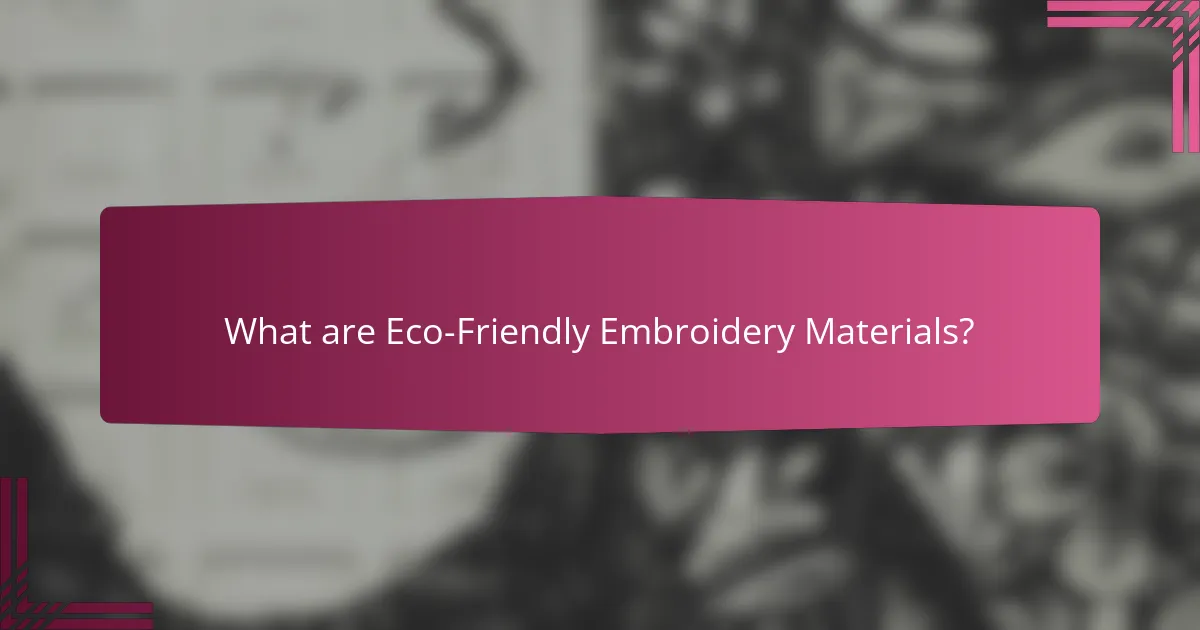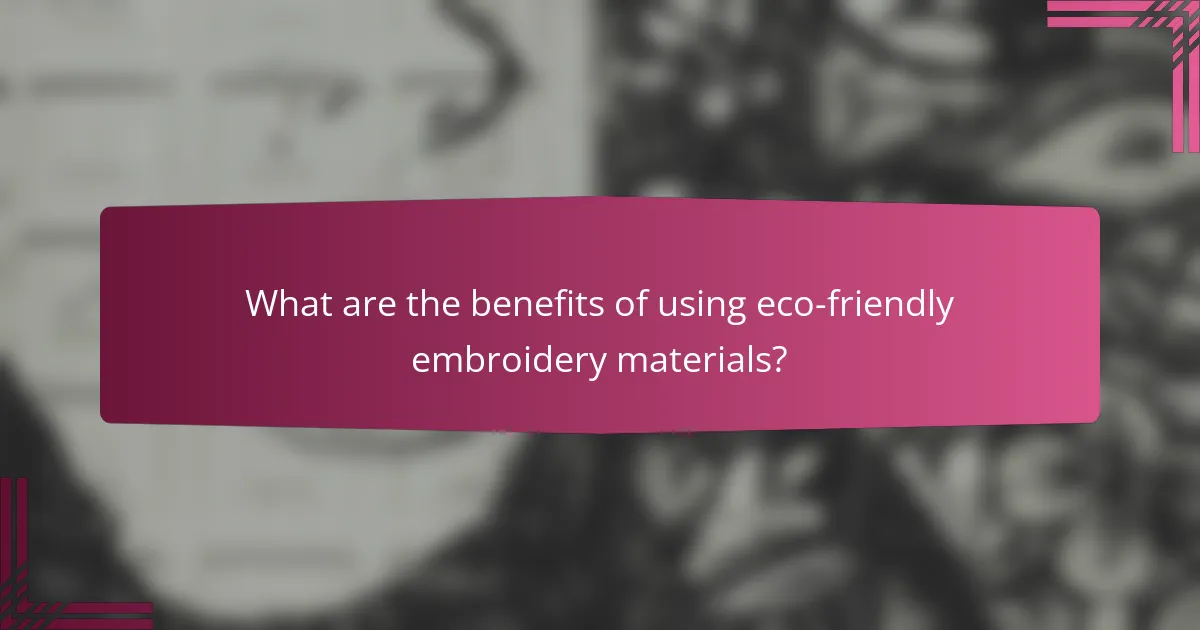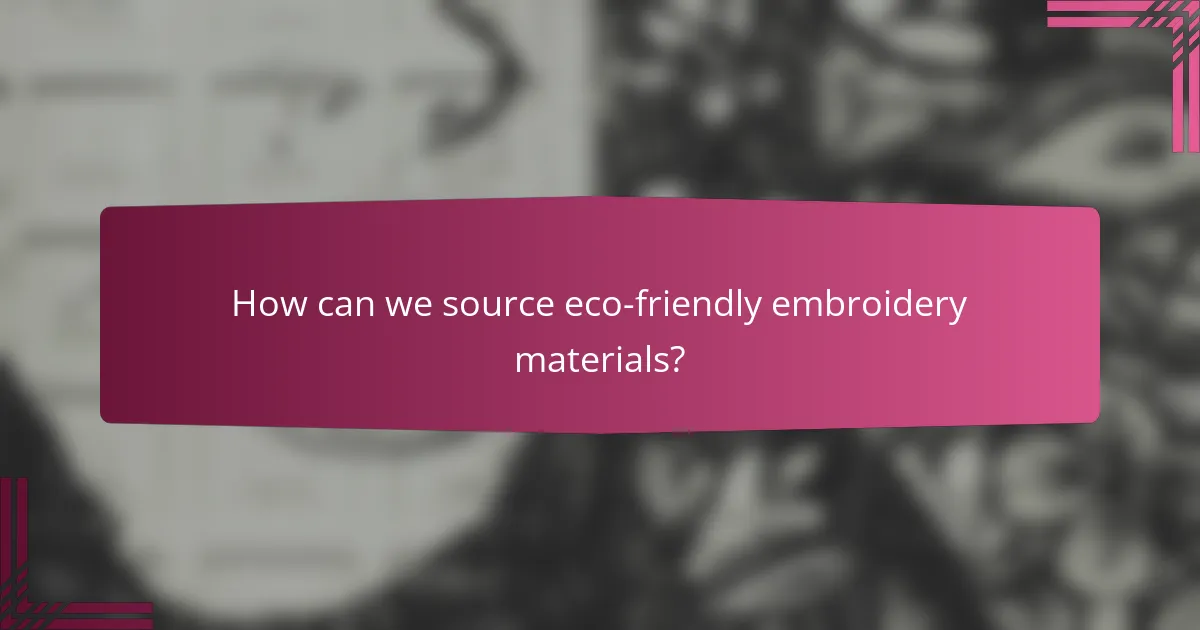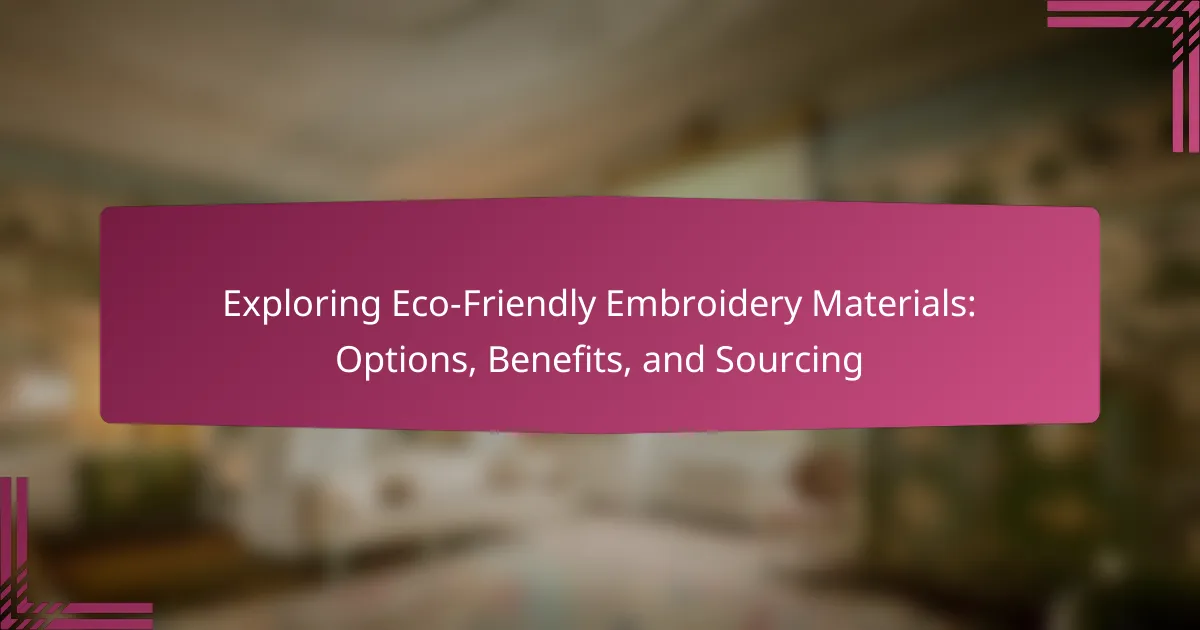
What are Eco-Friendly Embroidery Materials?
Eco-friendly embroidery materials are sustainable options used in textile decoration. These materials minimize environmental impact during production and disposal. Common eco-friendly materials include organic cotton, recycled polyester, and bamboo fibers. Organic cotton is grown without synthetic pesticides or fertilizers. Recycled polyester is made from post-consumer plastic bottles, reducing waste. Bamboo fibers are biodegradable and require less water than traditional cotton. Using these materials supports sustainable practices in the fashion industry. Studies show that eco-friendly textiles can reduce carbon emissions significantly compared to conventional fabrics.
Why should we consider eco-friendly options for embroidery?
Eco-friendly options for embroidery reduce environmental impact. Traditional embroidery materials often involve harmful chemicals and non-biodegradable components. Eco-friendly materials, such as organic cotton or recycled polyester, minimize pollution and waste. They promote sustainable practices by using renewable resources. Additionally, they support ethical labor practices in production. Choosing eco-friendly options aligns with consumer demand for sustainability. A report by the Ellen MacArthur Foundation states that textiles contribute significantly to global waste. Adopting eco-friendly embroidery practices can help decrease this waste significantly.
What environmental impacts do traditional embroidery materials have?
Traditional embroidery materials can have significant environmental impacts. Natural fibers like cotton require extensive water and pesticide use. Synthetic materials, such as polyester, contribute to microplastic pollution. The dyeing process often involves toxic chemicals that can contaminate water sources. Additionally, the production of these materials often results in high carbon emissions. Traditional embroidery practices may also lead to deforestation when sourcing materials. Overall, the environmental footprint of traditional embroidery materials is substantial and poses risks to ecosystems.
How do eco-friendly materials contribute to sustainability?
Eco-friendly materials contribute to sustainability by reducing environmental impact. These materials often come from renewable resources, minimizing depletion of natural resources. They typically require less energy during production, leading to lower greenhouse gas emissions. Many eco-friendly materials are biodegradable, reducing landfill waste. For instance, organic cotton uses 88% less water than conventional cotton. Additionally, they often involve sustainable farming practices, promoting biodiversity. Using eco-friendly materials can also support local economies by sourcing from ethical suppliers. Overall, their use fosters a more sustainable and responsible manufacturing process.
What types of eco-friendly embroidery materials are available?
Eco-friendly embroidery materials include organic cotton, hemp, bamboo, and recycled polyester. Organic cotton is grown without synthetic pesticides and fertilizers. Hemp is a durable, sustainable fiber that requires less water. Bamboo is biodegradable and grows rapidly, making it an eco-friendly choice. Recycled polyester is made from post-consumer plastic bottles, reducing waste. These materials reduce environmental impact and promote sustainable practices in the textile industry.
What are the characteristics of organic cotton as an embroidery material?
Organic cotton is a sustainable and eco-friendly embroidery material. It is grown without synthetic pesticides or fertilizers, promoting environmental health. The fibers are soft and breathable, enhancing comfort in finished products. Organic cotton has a natural sheen, which contributes to an attractive appearance in embroidery. It is durable and retains color well, ensuring longevity of designs. The material is hypoallergenic, making it suitable for sensitive skin. Additionally, organic cotton supports ethical farming practices, benefiting communities and ecosystems. These characteristics make organic cotton a preferred choice for environmentally conscious consumers.
How does recycled polyester compare to conventional polyester?
Recycled polyester is generally more environmentally friendly than conventional polyester. Conventional polyester is derived from petroleum-based resources, contributing to fossil fuel depletion. In contrast, recycled polyester is made from post-consumer plastic waste, reducing landfill contributions.
The production of recycled polyester uses less energy, often reported as 30-50% less than virgin polyester. This process also results in lower greenhouse gas emissions. Additionally, recycled polyester helps in reducing the demand for new plastic production.
Studies indicate that using recycled polyester can save significant amounts of water compared to conventional polyester production. For example, the Water Footprint Network reports that recycled polyester can use up to 90% less water.
Overall, recycled polyester presents a sustainable alternative, minimizing environmental impact while still providing similar performance characteristics to conventional polyester.
What other eco-friendly fibers can be used in embroidery?
Organic cotton is one eco-friendly fiber used in embroidery. It is grown without synthetic pesticides or fertilizers. This makes it a sustainable choice for textile production. Another option is hemp, which requires minimal water and no chemicals to grow. Hemp fibers are strong and durable, making them suitable for various embroidery projects. Bamboo is also an eco-friendly fiber. It grows quickly and can be processed into soft, breathable fabric. Tencel, made from sustainably sourced wood pulp, is another excellent choice. It is biodegradable and produced in a closed-loop process. Linen, derived from flax, is another sustainable option. It uses fewer resources and is biodegradable. These fibers contribute to environmentally friendly embroidery practices.

What are the benefits of using eco-friendly embroidery materials?
Eco-friendly embroidery materials offer multiple benefits. They reduce environmental impact by utilizing sustainable resources. These materials often use organic fibers, which minimize pesticide use. They are biodegradable, decreasing landfill waste. Eco-friendly options also promote healthier working conditions for farmers. Using these materials can enhance brand reputation. Consumers increasingly prefer sustainable products, leading to potential market advantages. Research indicates that eco-friendly practices can improve customer loyalty.
How do eco-friendly materials enhance the quality of embroidery?
Eco-friendly materials enhance the quality of embroidery by providing superior durability and vibrancy. These materials, such as organic cotton and recycled polyester, are often free from harmful chemicals. This absence of toxins results in brighter colors and improved fabric integrity. Additionally, eco-friendly fibers tend to have better moisture-wicking properties. This characteristic helps maintain the quality of the embroidery over time. Studies show that organic cotton has a higher thread strength compared to conventional cotton. This strength reduces the likelihood of fraying and wear. Overall, the use of eco-friendly materials leads to longer-lasting and visually appealing embroidered products.
What are the durability and longevity of eco-friendly embroidery materials?
Eco-friendly embroidery materials generally exhibit good durability and longevity. Many eco-friendly options, such as organic cotton and recycled polyester, resist wear and tear effectively. Organic cotton has a natural strength that withstands repeated washing. Recycled polyester is known for its resilience and ability to maintain color vibrancy over time. Additionally, some eco-friendly threads are treated for enhanced durability against fading and fraying. Research indicates that these materials can last as long as conventional counterparts when properly cared for. Studies show that the lifespan of organic cotton can exceed 5-10 years under regular usage conditions.
How do these materials affect the final appearance of embroidered products?
Eco-friendly embroidery materials significantly influence the final appearance of embroidered products. Natural fibers, such as organic cotton or linen, provide a softer and more textured finish. These materials often result in a more muted color palette, enhancing the organic aesthetic. Synthetic materials, like recycled polyester, can produce brighter colors and sharper details. They also offer durability, which maintains the design’s integrity over time. The choice of thread thickness impacts the overall texture and visibility of the embroidery. Thicker threads create a more pronounced design, while finer threads offer subtlety. Additionally, the environmental processes used in dyeing these materials can affect color fastness and vibrancy. For instance, low-impact dyes typically yield softer hues compared to conventional dyes.
What are the health benefits associated with eco-friendly embroidery materials?
Eco-friendly embroidery materials offer several health benefits. These materials are often made from natural fibers, which reduce exposure to harmful chemicals. Conventional embroidery materials may contain toxic dyes and additives. Using eco-friendly options minimizes allergic reactions and skin irritations. Natural fibers are also more breathable, promoting better skin health. Additionally, eco-friendly materials contribute to a healthier environment. A cleaner environment can lead to improved overall health for communities. Studies indicate that reducing chemical exposure can enhance well-being. Therefore, choosing eco-friendly embroidery materials supports both personal and environmental health.
How do eco-friendly materials reduce exposure to harmful chemicals?
Eco-friendly materials reduce exposure to harmful chemicals by using natural, non-toxic substances. These materials are often free from synthetic chemicals like pesticides and heavy metals. Conventional materials may release volatile organic compounds (VOCs) during production. In contrast, eco-friendly options minimize or eliminate VOC emissions. A study by the Environmental Protection Agency highlights that VOCs can cause respiratory issues and other health problems. By choosing eco-friendly materials, consumers lower their risk of exposure to these harmful substances. Additionally, sustainable production practices often involve less harmful processing methods. This further decreases the potential for chemical exposure in the final product.
What are the benefits for artisans working with eco-friendly materials?
Artisans working with eco-friendly materials benefit from enhanced market appeal. Eco-friendly products attract environmentally conscious consumers. This can lead to increased sales and customer loyalty. Additionally, using sustainable materials can reduce production costs in the long term. For example, natural fibers often require less energy to process. Artisans may also experience improved health outcomes. Eco-friendly materials typically contain fewer harmful chemicals. This can result in a safer working environment. Furthermore, artisans contribute to environmental conservation efforts. This aligns their work with global sustainability goals. Studies show that sustainable practices can enhance brand reputation. Overall, artisans gain both economic and social advantages by choosing eco-friendly materials.

How can we source eco-friendly embroidery materials?
Sourcing eco-friendly embroidery materials can be achieved through several methods. First, identify suppliers that specialize in sustainable textiles. Look for certifications such as Global Organic Textile Standard (GOTS) or OEKO-TEX. These certifications ensure materials meet environmental and safety standards.
Next, consider using natural fibers like organic cotton, hemp, or linen. These materials are biodegradable and have a lower environmental impact. Additionally, seek out recycled or upcycled fabrics. These options reduce waste and promote circular fashion practices.
Research local artisans or manufacturers who prioritize eco-friendly practices. Supporting local businesses can reduce transportation emissions. Attend trade shows focused on sustainable fashion to discover new suppliers and materials.
Finally, utilize online platforms dedicated to sustainable materials. Websites like EcoFabric or Fabric.com offer a range of eco-friendly options. By following these steps, you can effectively source eco-friendly embroidery materials.
Where can we find reliable suppliers for eco-friendly embroidery materials?
Reliable suppliers for eco-friendly embroidery materials can be found through various channels. Online marketplaces like Etsy and Amazon feature sellers specializing in sustainable materials. Additionally, industry-specific websites such as Fabric.com and EcoFabric offer eco-friendly options. Local fabric stores often carry organic and recycled materials. Trade shows focused on sustainable textiles provide networking opportunities with suppliers. Organizations like the Sustainable Apparel Coalition also list certified suppliers. Researching supplier reviews and sustainability certifications can ensure reliability.
What certifications should we look for when sourcing these materials?
Look for certifications such as Global Organic Textile Standard (GOTS) and OEKO-TEX Standard 100 when sourcing eco-friendly embroidery materials. GOTS certifies organic fibers and ensures environmentally friendly processing. OEKO-TEX Standard 100 guarantees that textiles are tested for harmful substances. Additionally, look for certifications like Fair Trade and Cradle to Cradle. Fair Trade ensures ethical labor practices and sustainable sourcing. Cradle to Cradle focuses on materials that are safe and circular. These certifications validate the sustainability and ethical standards of the materials.
How can we verify the sustainability claims of suppliers?
To verify the sustainability claims of suppliers, conduct thorough assessments. Request documentation such as certifications from recognized organizations. Look for third-party audits that validate sustainability practices. Analyze the supplier’s supply chain for transparency and ethical sourcing. Review their environmental impact reports for measurable data. Check for adherence to industry standards like ISO 14001. Engage with stakeholders or previous clients for firsthand accounts. Utilize tools like the Higg Index for a comprehensive evaluation of sustainability practices.
What are some best practices for sourcing eco-friendly embroidery materials?
Sourcing eco-friendly embroidery materials involves several best practices. First, prioritize organic fabrics made from materials like cotton or linen. These materials are grown without harmful pesticides. Next, consider recycled fibers, which reduce waste and environmental impact. Certifications such as Global Organic Textile Standard (GOTS) ensure materials meet eco-friendly criteria. Collaborating with suppliers who emphasize sustainability is crucial. Research suppliers’ practices to confirm their commitment to eco-friendliness. Additionally, local sourcing can minimize transportation emissions. Finally, engage in transparent supply chains to ensure ethical production. These practices collectively support sustainable embroidery initiatives.
How can we build relationships with eco-friendly suppliers?
To build relationships with eco-friendly suppliers, prioritize open communication and transparency. Establish regular contact to discuss shared values and goals. Attend industry events focused on sustainability to network with potential suppliers. Collaborate on projects that promote eco-friendly practices. Offer feedback and support to suppliers to strengthen the partnership. Utilize online platforms to research and connect with eco-conscious brands. According to a 2020 report by McKinsey, 66% of consumers are willing to pay more for sustainable brands, highlighting the importance of aligning with eco-friendly suppliers.
What tips can help us make informed decisions about material sourcing?
Research suppliers thoroughly to ensure they adhere to sustainability standards. Evaluate their certifications, such as GOTS or OEKO-TEX. Compare material options based on environmental impact and resource usage. Assess the lifecycle of materials, including sourcing, production, and disposal. Engage with suppliers to discuss their sourcing practices and transparency. Seek feedback from other businesses regarding their sourcing experiences. Stay updated on industry trends and innovations in eco-friendly materials. Utilize online platforms and resources for additional insights into sustainable sourcing practices.
What are the common challenges in sourcing eco-friendly embroidery materials?
Common challenges in sourcing eco-friendly embroidery materials include limited availability and higher costs. Many suppliers do not stock sustainable options. This scarcity can lead to longer lead times for orders. Additionally, eco-friendly materials may not always meet traditional quality standards. Some consumers are also unaware of the benefits of these materials. This lack of awareness can reduce demand, impacting supply chains. Furthermore, certification processes for eco-friendly materials can be complex and time-consuming. These challenges make sourcing eco-friendly embroidery materials more difficult for businesses.
How can we overcome cost barriers associated with eco-friendly materials?
To overcome cost barriers associated with eco-friendly materials, we can prioritize bulk purchasing and local sourcing. Bulk purchasing reduces unit costs and can lead to significant savings. Local sourcing minimizes transportation costs and supports regional economies. Additionally, investing in research and development can lead to innovative production methods that lower costs over time. For instance, studies show that economies of scale can reduce production costs by up to 30%. Collaborating with suppliers to create long-term contracts can also stabilize prices and enhance affordability. Furthermore, government incentives for sustainable practices can provide financial relief. According to the Environmental Protection Agency, such incentives can reduce overall project costs significantly.
What strategies can we use to navigate supply chain issues?
Diversifying suppliers is a key strategy to navigate supply chain issues. This approach reduces dependency on a single source. It mitigates risks associated with disruptions. Establishing relationships with multiple suppliers ensures alternative options. Implementing technology for real-time tracking enhances visibility. This allows for proactive responses to delays. Investing in inventory management systems helps maintain optimal stock levels. These systems can predict shortages and adjust orders accordingly. Lastly, fostering strong communication with suppliers builds trust and collaboration. This can lead to more flexible arrangements during crises.
Eco-friendly embroidery materials, including organic cotton, recycled polyester, and bamboo fibers, are sustainable options that minimize environmental impact during production and disposal. This article explores the various types of eco-friendly materials, their benefits, and their role in promoting sustainability in the fashion industry. It also discusses the environmental impacts of traditional embroidery materials, highlights the characteristics and advantages of eco-friendly options, and provides guidance on sourcing these materials, including best practices and potential challenges. Additionally, the article addresses the health benefits associated with eco-friendly materials and offers strategies for artisans and businesses to effectively navigate the sourcing process.
